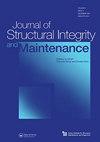Physical and numerical models of pressure during waterproofing injections with polymer into concrete fractures
IF 3.1
Q2 ENGINEERING, CIVIL
Journal of Structural Integrity and Maintenance
Pub Date : 2023-07-03
DOI:10.1080/24705314.2023.2233802
引用次数: 0
Abstract
ABSTRACT Polymer injections in concrete fractures are commonly used for the waterproofing of tunnels. The pressure during the injection needs to be high enough to ensure polymer penetrability. This paper introduces two physical models for the study of the pressure inside concrete fractures during polymer injections. The injection parameters that were varied include pressure, injection duration, injection volume, location of the injection and pressure reading ports, and fluid dynamic viscosity. Water and water-glycerol mixtures were used to verify the influence of viscosity on flow. Tests were performed with both open and sealed fractures. The pressure inside the fracture during the injection was influenced by the dynamic viscosity, boundary conditions and the saturation level of the fracture. Sealed and initially moist fractures led to a higher pressure gain inside the fracture after achieving saturation. More than 40% of the injection pressure was already lost when the liquid entered the model. A numerical model of liquid flow in the fracture plane was developed with the finite element code COMSOL Multiphysics. It was able to replicate the influence of boundary conditions and initial fracture saturation on pressure. The model also shows how aperture and roughness influence the flow conditions in the fracture.混凝土裂缝中聚合物防水注入压力的物理和数值模型
混凝土裂缝注入聚合物是隧道防水的常用方法。注入过程中的压力需要足够高,以确保聚合物的渗透性。本文介绍了两种用于研究聚合物注入混凝土裂缝内压力的物理模型。不同的注入参数包括压力、注入时间、注入量、注入位置和压力读数端口以及流体动态粘度。用水和水-甘油混合物验证了粘度对流动的影响。在开放性和封闭性骨折中均进行了测试。注入过程中裂缝内压力受动态粘度、边界条件和裂缝饱和度的影响。密封裂缝和最初的湿润裂缝在达到饱和后会导致裂缝内部的压力增加。当液体进入模型时,已经损失了超过40%的注射压力。利用有限元软件COMSOL Multiphysics建立了裂缝平面内液体流动的数值模型。它能够复制边界条件和初始裂缝饱和度对压力的影响。该模型还显示了孔径和粗糙度对裂缝内流动状况的影响。
本文章由计算机程序翻译,如有差异,请以英文原文为准。
求助全文
约1分钟内获得全文
求助全文
来源期刊

Journal of Structural Integrity and Maintenance
ENGINEERING, CIVIL-
CiteScore
3.90
自引率
9.50%
发文量
24
 求助内容:
求助内容: 应助结果提醒方式:
应助结果提醒方式:


